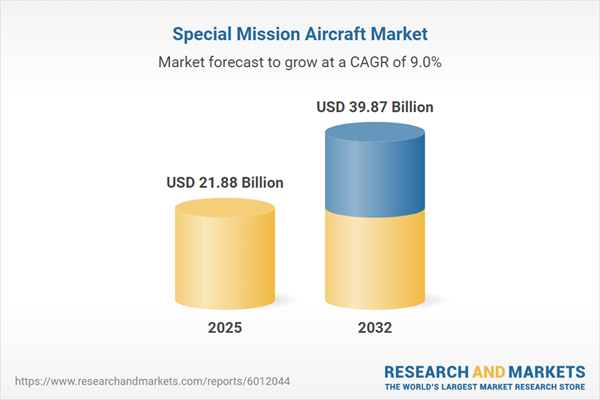Speak directly to the analyst to clarify any post sales queries you may have.
The Special Mission Aircraft Market is undergoing a paradigm shift as defense, security, and public agencies rapidly adopt advanced airborne platforms to address increasingly complex operational challenges worldwide. This report provides senior decision-makers with actionable clarity on the sector’s evolving landscape, highlighting the main growth drivers, technology adoption, and future outlook.
Market Snapshot: Special Mission Aircraft Market
The Special Mission Aircraft Market experienced robust growth from USD 20.06 billion in 2024 to USD 21.88 billion in 2025 and is projected to expand at a CAGR of 8.96%, reaching USD 39.87 billion by 2032. This growth is fuelled by heightened security demands, increased international tensions, and rapid technology integration into multi-role platforms. The market is seeing active investments from governments and private sector stakeholders, particularly in surveillance, reconnaissance, border security, humanitarian assistance, and electronic warfare domains.
Scope & Segmentation
This report delivers a comprehensive segmentation analysis to guide strategic planning and procurement:
- Mission Types: Airborne early warning and control, border patrol activities, electronic warfare (attack, protection, support), intelligence (communications, imagery, measurement/signature, and signals), maritime patrol, medical evacuation, and search and rescue.
- Platform Types: Fixed wing, rotary wing (categorized as heavy, medium, and light), and a diverse array of unmanned aerial vehicles including high altitude long endurance, medium altitude long endurance, and tactical UAVs.
- Propulsion Types: Electric systems for short missions, piston engines for cost-driven operations, and advanced turbofan and turboprop technologies for performance optimization and extended missions.
- End Users: Military branches (air force, army, navy), para-military organizations (coast guard, customs enforcement, police), as well as civilian operators (emergency medical services, firefighting, surveying, and mapping).
- Operational Range: Solutions tailored to long, medium, and short-range missions to provide appropriate coverage and rapid response in various scenarios.
- Weight Classes: Platforms classified as light, medium, and heavy to match different mission requirements and logistical considerations.
- Geographic Coverage: Analysis covers key regions and nations within the Americas (including U.S., Canada, Mexico, Brazil, Argentina, Colombia, and Peru), Europe (United Kingdom, Germany, France, Russia, Italy, Spain, Netherlands, Sweden, Poland, Switzerland), Middle East (UAE, Saudi Arabia, Qatar, Turkey, Israel), Africa (South Africa, Nigeria, Egypt, Kenya), and Asia-Pacific (China, India, Japan, Australia, South Korea, Indonesia, Thailand, Malaysia, Singapore, Taiwan).
- Company Profiles: In-depth evaluation of major players such as The Boeing Company, Lockheed Martin Corporation, Northrop Grumman Corporation, Airbus SE, Dassault Aviation, Leonardo S.p.A., Textron Aviation Inc., Bombardier Inc., Embraer S.A., and Gulfstream Aerospace Corporation.
Key Takeaways
- Special mission aircraft offer unmatched operational flexibility across defense, border security, and humanitarian missions, leveraging real-time data links, advanced sensors, and improved interoperability for multi-domain operations.
- Integration of artificial intelligence, machine learning, and autonomous systems is driving higher efficiency and rapid situational awareness, reducing operator workload and enhancing decision support.
- The rise of unmanned aerial vehicles is shifting mission paradigms, paving the way for safer, longer, and more diverse mission profiles while addressing personnel risk.
- Collaborative partnerships among manufacturers, technology providers, and government agencies are accelerating innovation cycles, sharing development risk, and introducing co-production models to strengthen supply chains.
- Market competition is intensifying, with traditional primes, integrators, and emerging firms focusing on digital backbone capabilities, open architectures, and aftermarket services such as predictive maintenance and modular upgrades to sustain customer value.
Tariff Impact and Policy Shifts
Recent United States tariffs enacted in 2025 have notably altered procurement dynamics. Increased import duties are leading to cost adjustments throughout the supply chain, driving program managers to reconsider supplier strategies and favor domestic or cost-absorbing partners. Simultaneously, these changes are motivating new co-development initiatives among U.S. and allied defense agencies, strengthening industry ties and prompting fresh approaches to supply chain risk management within the special mission aircraft ecosystem.
Methodology & Data Sources
This report is based on integrated primary and secondary research. Expert consultations with defense planners, program managers, and technical authorities informed the interpretation of real-world market trends. The analysis is further supported by review of official documents, technical journals, and open-source intelligence, validated through data triangulation and rigorous peer review to maintain objectivity.
Why This Report Matters
- Enables senior leaders to make data-driven decisions regarding asset procurement, supply chain resilience, and capability development in the special mission aircraft sector.
- Presents a clear segmentation and competitive landscape, aiding in aligning technology investments with specific mission, platform, and regional requirements.
- Offers insights into the impact of policy changes—such as tariffs—and the importance of industry collaboration and modular system architectures for future-proofing operations.
Conclusion
The Special Mission Aircraft Market is at a decisive juncture, with technology innovation, evolving missions, and supply chain strategies defining the path forward. Stakeholders equipped with accurate market intelligence will be better positioned to drive success and sustain technological leadership amid ongoing change.
Additional Product Information:
- Purchase of this report includes 1 year online access with quarterly updates.
- This report can be updated on request. Please contact our Customer Experience team using the Ask a Question widget on our website.
Table of Contents
3. Executive Summary
4. Market Overview
7. Cumulative Impact of Artificial Intelligence 2025
Companies Mentioned
The companies profiled in this Special Mission Aircraft market report include:- The Boeing Company
- Lockheed Martin Corporation
- Northrop Grumman Corporation
- Airbus SE
- Dassault Aviation
- Leonardo S.p.A.
- Textron Aviation Inc.
- Bombardier Inc.
- Embraer S.A.
- Gulfstream Aerospace Corporation
Table Information
| Report Attribute | Details |
|---|---|
| No. of Pages | 187 |
| Published | October 2025 |
| Forecast Period | 2025 - 2032 |
| Estimated Market Value ( USD | $ 21.88 Billion |
| Forecasted Market Value ( USD | $ 39.87 Billion |
| Compound Annual Growth Rate | 8.9% |
| Regions Covered | Global |
| No. of Companies Mentioned | 11 |









